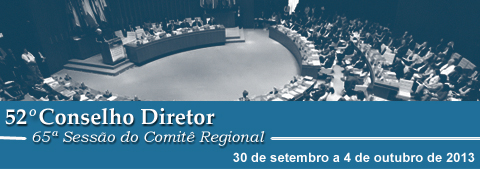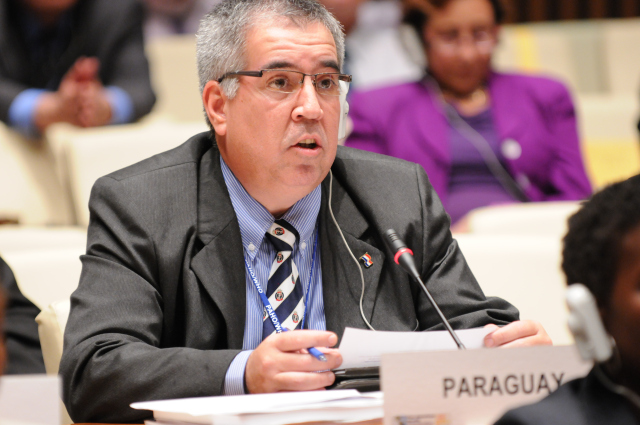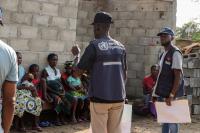Directing Council of PAHO reaffirms commitment to achieving the Regional Goals for Human Resources for Health 2007-2015
 Meeting in Washington from September 30 to October 4, the Directing Council and the Regional Committee of the Pan American Health Organization (PAHO/WHO) assess the issue of human resources for health (HRH) and reaffirm the commitment of the Organization to this theme. The discussions held during the meeting had as its starting point the document 'Human Resources for Health : improve access to skilled health professionals in health systems based on primary health care' (CD52/6), prepared at the request of the 152nd Session Executive Committee of PAHO, held from 17 to 21 June 2013.
Meeting in Washington from September 30 to October 4, the Directing Council and the Regional Committee of the Pan American Health Organization (PAHO/WHO) assess the issue of human resources for health (HRH) and reaffirm the commitment of the Organization to this theme. The discussions held during the meeting had as its starting point the document 'Human Resources for Health : improve access to skilled health professionals in health systems based on primary health care' (CD52/6), prepared at the request of the 152nd Session Executive Committee of PAHO, held from 17 to 21 June 2013.
The discussions held during the meeting had as its starting point the document ‘Human Resources for Health: Increasing Access to Qualified Health Workers in Primary Health Care-based Health Systems’ (CD52/6), developed at the request of the 152nd Session of the Executive Committee, 17–21 June 2013. Builds on previous resolutions of, the DC52/6 attempts to identify critical reforms and policy orientations needed to increase access to qualified health workers in PHC-based health systems, with particular attention to underserved and vulnerable communities. It stresses the importance of developing new models of HRH governance and of strengthening collaborative HRH planning capacity.
According to the text, the monitoring of the Regional Goals for Human Resources for Health 2007-2015 will facilitate the assessment of progress throughout the Region with regard to the situation of the health workforce and its contribution to the development of PHCoriented health systems. Ensuring the availability and accessibility of qualified health personnel with the relevant technical and cultural competencies to address the needs of underserved and vulnerable communities remains a challenge for national health authorities. As an example, there are currently approximately 5,900 designated Primary Care Health Professionals Shortage Areas (HPSA) in the United States of America. Depending on the criteria used, it is estimated that 7,550 to 16,000 additional primary care physicians would be needed to eliminate the current primary care HPSA designations. A similar 2010 study in Brazil showed that there were 1,280 municipalities with a shortage of physicians, representing more than 28 million people, mainly in the North-eastern and Northern regions.
The 20 Regional Goals for Human Resources for Health 2007-2015, adopted by the Pan American Sanitary Conference in 2007, were formulated on the basis of the core values, and elements of a PHC-based health system. These core values include: the right to the highest attainable level of health, equity and solidarity. The current assessment and monitoring of the Regional Goals provides information on the progress being made at country and regional levels. Although it is not yet complete, the assessment has already focused attention on critical obstacles to achieving further advances in reducing inequities and improving access to qualified health workers. The goal of universal health coverage should provide additional impetus to confront these problems and make the anticipated benefits of UHC real to all members of society.
Strategic importance of the HRH
After the discussions, the Council reaffirmed the strategic importance of human resources for health (HRH) for the achievement of the goal of universal health coverage (UHC) grounded in the development of health systems based on primary health care (PHC), and the improvement of the health and well-being of individuals, families, and communities, and expressed its concern by the persistent inequalities in access to quality and comprehensive health care services attributable to health personnel shortages in remote and rural areas and among underserved or vulnerable population groups and communities.
Considering the adoption by the 63rd World Health Assembly of the WHO Global Code of Practice on the International Recruitment of Health Personnel, which addresses challenges posed by the mobility of health professionals between and within countries, the Council concluded the debate on the topic, urging Member States reiterate their commitment to achieving the Regional Goals for Human Resources for Health 2007-2015.
The Council stressed the importance for countries to establish and strengthen a strategic planning and management unit for human
resources for health with the capacity to lead, engage, and generate consensus among national education authorities, academic health centers, professional associations, state and local health authorities, health centers, and community organizations on current and future HRH needs, in particular for PHC-based health systems.
 Council also requested the Director of PAHO to intensify the technical cooperation of the Organization with and between Members States to develop human resources policies and plans guided by the overarching objective of universal health coverage and the strategy of primary health care. About this topic, the delegate of Paraguay, Cesar Cabral Mereles (photo), stated that his country supports the renewed policy for cooperation for health development in the Americas and recognized the efforts of the Pan American Health Organization, adding that it is important for PAHO to continue being a leader in health and partnerships-building. He also said that PAHO should emphasize that, even though improvements have been achieved in the Americas in recent years, inequities remain that need to be addressed. This is particularly important as international cooperation agencies divert resources from the Region, which is considered middle-income, to other parts of the world.
Council also requested the Director of PAHO to intensify the technical cooperation of the Organization with and between Members States to develop human resources policies and plans guided by the overarching objective of universal health coverage and the strategy of primary health care. About this topic, the delegate of Paraguay, Cesar Cabral Mereles (photo), stated that his country supports the renewed policy for cooperation for health development in the Americas and recognized the efforts of the Pan American Health Organization, adding that it is important for PAHO to continue being a leader in health and partnerships-building. He also said that PAHO should emphasize that, even though improvements have been achieved in the Americas in recent years, inequities remain that need to be addressed. This is particularly important as international cooperation agencies divert resources from the Region, which is considered middle-income, to other parts of the world.
Another request was on maintenance and improvement of the main regional networks of knowledge sharing in RHS, namely the Regional Observatory of Human Resources in Health Virtual Campus for Public Health and Ambulatory Virtual Learning, and finalize the evaluation of 20 regional Goals for Human Resources for Health 2007-2015 and initiate regional consultation on HRH development agenda post -2015, among other things.
Besides the issue of RHR, the Council addressed topics such as Social Protection in Health, Plan of Action for the Prevention and Control of Noncommunicable Diseases, and Implementation of the International Health Regulations. During the meeting, the board also elected Health Surveillance Secretary of the Ministry of Health of Brazil, Jarbas Barbosa, as chairman of the Executive Committee of the Pan American Health Organization (PAHO) for 2013-2014. Delegates from Canada and Chile were elected respectively as vice president and rapporteur for the same period Instances policies PAHO WHO.
Governing bodies of the PAHO/WHO
The Pan American Sanitary Conference is the supreme governing authority of the Organization and meets every five years to determine its general policies. The Conference also serves as a forum for the interchange of information and ideas relating to the prevention of disease; the preservation, promotion and restoration of mental and physical health; and the advancement of sociomedical measures and facilities for the prevention and treatment of physical and mental diseases in the Western Hemisphere.
The Directing Council meets once a year in those years when the Conference does not meet. It acts on behalf of the Conference between sessions of the Conference.
The Executive Committee is composed of nine Member States of the Organization, elected by the Conference or the Council for overlapping periods of three years. The Committee, which meets twice a year, acts as a working party of the Conference or Council.Special meetings are convoked by the Director of the Bureau either on his/her own initiative or upon request of at least three Member States. The Committee has an auxiliary advisory body, the Subcommittee on Program, Budget, and Administration.



